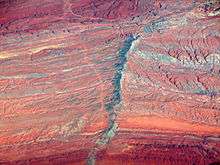Diatreme

A diatreme, sometimes known as a maar-diatreme volcano, is a volcanic pipe formed by a gaseous explosion. When magma rises up through a crack in the Earth's crust and makes contact with a shallow body of ground water, rapid expansion of heated water vapor and volcanic gases can cause a series of explosions. A relatively shallow crater is left (known as a maar) and a rock filled fracture (the actual diatreme) in the Earth's crust. Diatremes breach the Earth's surface and produce a steep inverted cone shape.
The term diatreme has been applied more generally to any concave body of broken rock formed by explosive or hydrostatic forces, whether or not it is related to volcanism.
Global distribution
Maar-diatreme volcanoes are not uncommon, reported as the second most common type of volcanoes on continents and islands.
Igneous intrusions cause the formation of a diatreme, only in the specific setting where groundwater exists. This means most igneous intrusions do not produce diatremes.
Economic importance
Diatreme formation is sometimes associated with kimberlite magma, which originates in the upper mantle. When a diatreme is formed due to a kimberlite intrusion, there is a possibility that diamonds may be brought up, because diamonds are formed in the upper mantle at depths of 150-200 kilometers. Kimberlite magmas can sometimes include chunks of diamond as xenoliths, making them economically significant.
Diatremes are sometimes associated with deposition of economically significant mineral deposits. A significant diatreme event was that which formed the giant Sullivan galena (lead-zinc-silver) orebody in British Columbia, Canada. Other diatremes in British Columbia include the Blackfoot diatreme and Cross diatreme.
References
- Kimberlite Emplacement Models
- Gannon, Megan, Maar-Diatreme Volcano Research May Help Geologists Predict Eruptions, Find Diamonds, Huffington Post, Posted: 10/07/2012
- Kimberlite Diatremes, Colorado Geological Survey, 10-17-2012
- Lorenz, Volker, Maar-Diatreme Volcanoes, their Formation, and their Setting in Hard-rock or Soft-rock Environments, Geolines, v. 15, 2003, pp. 72-83
- Definition from blogspot.com